MKII Upgrade for the PS Audio PWD
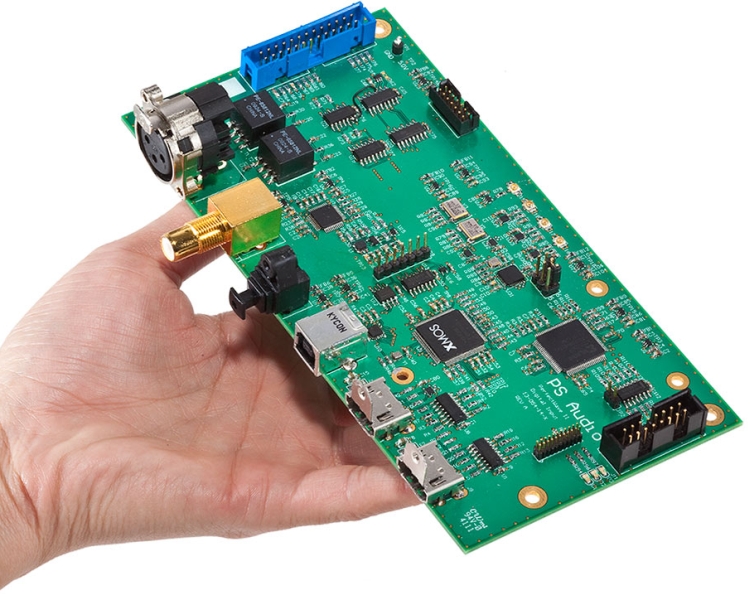
An upgrade that transforms the PWD
The PS Audio PWD was nothing short of a revolution at its introduction. Linn may have beaten them to the punch with the Klimax DS, and although the latter was even better in certain areas, at its price, the PWD couldn’t be matched by anything else on the market. Not for audio quality and neither in terms of innovative thinking and versatility. Compared to top high-end equipment, the PWD had some weaker areas, as indicated in my original review, such as a treble coarseness and some lack of fluidity. Well, brace yourselves, as these aspects have not only been improved, all other aspects of the sound have been improved upon!
See also the original review: PS Audio PWD
Retail price of the upgrade kit approx 1000 euro
1000 euro may sound like a lot of money. But really it is very reasonable. Let me try to explain. First, let’s look at what it is: you could categorize it as some sort of soundcard, but a highly sophisticated one at that. What does a PC soundcard cost? 60 euro I hear you say, and that’s correct, for a regular SoundBlaster. But remember: we’re talking high sophistication here. So, let’s move all the way up this company’s soundcard ladder and just select the best the brand has to offer and take the EMU1212M, or its successor the 1616M and we’re talking at least 300 euro. Move up to the truely professional soundcards and we’re talking multiples of that. And this is only possible as long as they can make and sell millions of them. Then consider that this board has been custom designed with the best high end audio quality in mind and that it sells in thousands rather than millions. Finally, it becomes positively affordable if you compare it to the cost involved in an upgrade for the Linn Klimax DS.
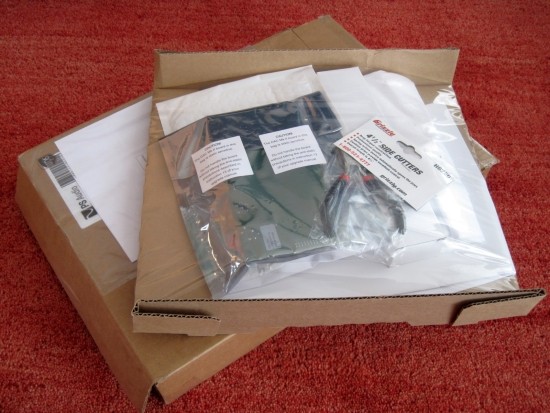
This kit is super-complete, even including all tools you need!
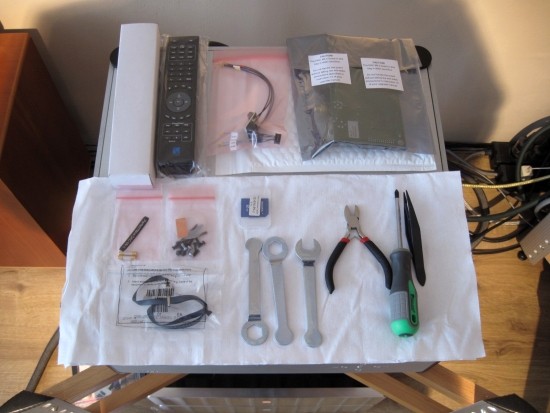
What’s in the MKII Upgrade Kit:
2 variations of I2S connection cables
new screws
new MKII nameplate
new Gold Plated fuses
new firmware on a 2GB SD card
new IR remote control
2 pieces of copper tape
Philips screwdriver
3 wrenches
Pliers
Plastic tweezer
Anti-static Wrist Strap
Highly detailed, full colour instruction manual
Even the soft fabric on which the parts are displayed, is included!
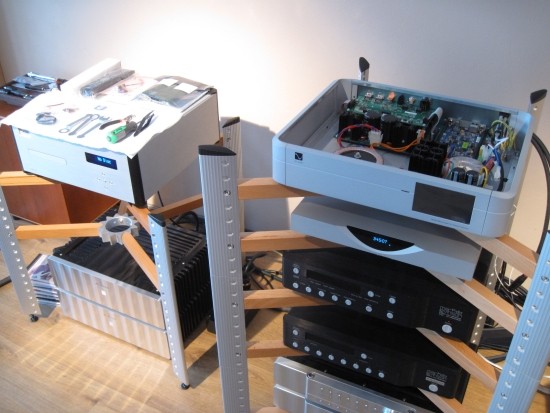
The Upgrade
Against regulations, I decided to do the upgrade with the PWD still in its place on the Spider rack. Naturally I did take all precautions with respect to protecting the sensitive electronics from static charges. The instruction manual is very elaborate and I must confess to having started before entirely having read all instructions. It wasn’t the first time I had opened the PWD. The first time was to install better fuses, by Furutech. Even though the KIT included new fuses, I decided to leave the Furutechs in place. When the time came to take out the old input board, I did read all relevant info in the instruction manual, just to make sure that I wouldn’t forget anything. Removal was very simple but there was one hurdle to take: after snipping the lead wires of the sp/dif input and removing the board, the connector wouldn’t come out. It was really stuck, and finally I decided to take it out with big pliers. It came out without damage to the PWD’s housing and after this there were no more problems.
Inside the kit are new screws and even a new MKII nameplate, so even if you’ve damaged the old screws, the PWD will look as new once the new screws are in place.
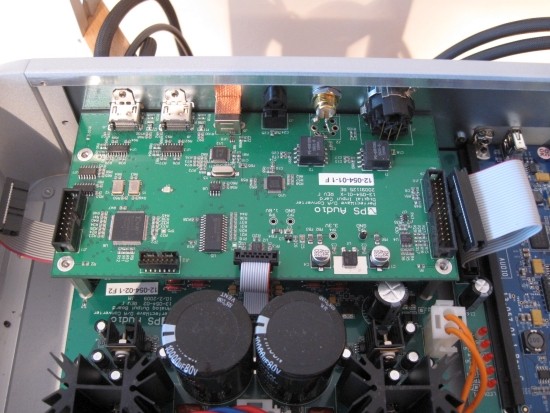
Above: Old digital input board before removal
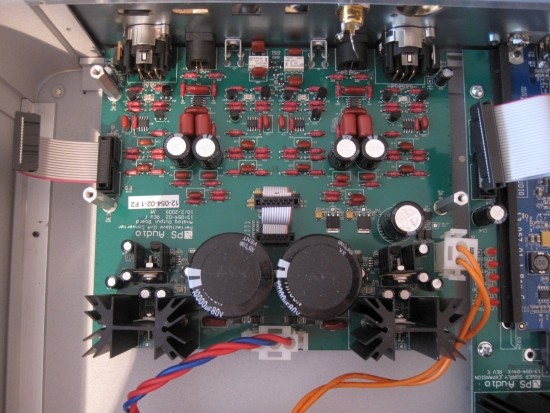
Above: Analog output board in its full glory after removal of the digital input board
This was the first time I could take a good look at the analog output board. It may not be as elaborate as a Mark Levinson output stage, but it is very well built, fully symmetric, with plenty of high quality capacitors and even discrete output devices.
After screwing everything back together and looking at the remaining accessories, I noticed that I had forgotten to re-apply the coppertape to the USB input. Ah well, that can be done the next time I open it. This brought me to the moment that power could be re-applied and the new firmware loaded. This was really child’s play: insert the SD card, turn on power and just wait. Within minutes all is done and the unit is ready to play music.
The Sound – before the swap
Before the swap, I had made a playlist consisting of various sources of material and listened to all tracks carefully, making notes of all good things and bad things I noticed. Referring back to the original review overall I found much to like in the PWD MKI such as its livelike character, its deep, full yet articulate bass, and its well-focused, 3D soundstage, almost resembling a typical Wadia CD player in these areas. All these aspects were still present while I went through the playlist. I also noticed once again the few downsides that made the PWD less desirable for me, which were the somewhat blocky, low resolution treble with some brittleness and the subjective feeling of a ceiling being present on top of the treble, preventing it from having the air I like to be present in music. Also I find the PWD to sound slightly mechanical at times. Still, its lack of artifice, its superb bass, its rhythmic qualities and its 3D soundstaging made it stand out above all other computer audio solutions I had tried until that point. The PWD MKI may not have had the best treble in the world, nor the smoothest presentation, but it never sounded like computer audio. This made it my preferred component until I heard the Linn Klimax DS. The Linn made clear that I wasn’t overreacting about the PWD’s treble. The Klimax DS is sooooo smooth, so utterly finely resolved that it has to be heard to be believed. Its low level resolution is the best I’ve heard, even better than my beloved Mark Levinson no.390S cd player. What’s more: the Linn doesn’t sound thin or gray, like the cheaper Linns that I have experience with. It has lots of colour and cream. But it doesn’t have the PWD’s rhythmic presence or its lively dynamics, nor its bass solidity or soundstaging. To my ears, the Klimax DS is quite clearly the better machine, but it isn’t always more involving. So, it’s also a matter of taste.
The Sound – after the swap
With great anticipation I reloaded the playlist and started listening. Already within the first minute of the first song I thought: this is sooo much smoother, so much cleaner, so much more refined! But I couldn’t quite believe it so I proceeded through the playlist. But sure enough: track after track my opinion solidified until I could say with complete certainty that this was nothing short of a transformation. The upgrade was done in the afternoon, and from the moment I switched the PWD back on, I first listened to the 20 track playlist but couldn’t stop and proceeded listening to countless other tracks until it was time to go to bed. The following may sound overexaggerated, but each and every track I played made me want to play more. Most obvious is the enormous jumpfactor, the thing that makes for toe tapping and excellent PRAT. Dynamic contrasts are so large and there’s so much variation going from track to track that the music just never loses its interest, and I didn’t even want to start comparing to the Klimax DS. I knew it had to be done, but just not that night. Track after track it became clearer that various aspects of the sound had been improved. Although I could hear that the treble was still not as airy and refined as that of the Klimax DS, it was now much smoother and much more fluid than it was before, certainly no longer having any obvious brittleness, nor the obvious treble ceiling. So, the treble had improved immensely but would you believe me if I said that various other aspects had improved even further? The whole sound image was now cleaner, more refined, smoother, more organic, more emotional and less technical. The soundstage was wider, larger and deeper, with clearer defined imaged within it, but more spaced out, with more air inbetween them. At the same time the sound was more mellow, more relaxed. Low level resolution was also much better, although it still wasn’t at the ridiculously high level that the Linn Klimax achieves. But this is only one aspect of the sound, and in light of everything else that is so good, this is a minor thing. Thankfully, the PWD’s awesome bass was still awesome. I’m not sure if it also got better, but in any case it didn’t get lose any of its fulness and articulation. If anything, it had better timing. The PWD MKI already reminded me of the Wadia sound, but the MKII takes it even further, and it might well be that it now even surpasses some of Wadia’s trademark strong areas. In order to test this, I have the Wadia S7i on loan, with which we will make a direct comparison. But first, here’s my experience with comparing the PWD MKII directly to the Linn Klimax DS/0.
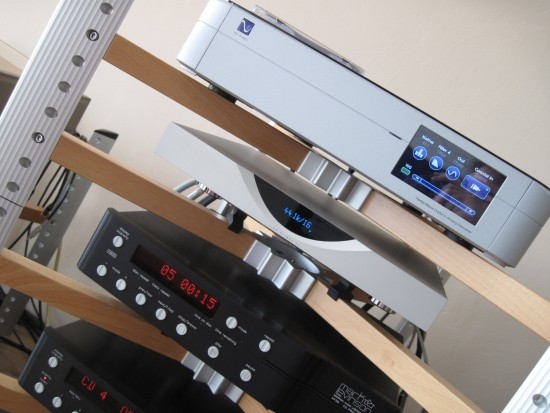
The Sound – compared directly with the Linn Klimax DS
My initial expectations were mostly correct: the Linn was indeed more airy and more refined. The Klimax DS just seems to have infinite resolution, like an Apple Retina TFT display compared to a regular TFT display. If it has any grain, it is so small that it cannot be detected. This was as expected, but what I did not expect was to be slightly disappointed by the DS! You see, at this point I discovered that I had not yet selected the NativeX setting on the PWD. This engages an extra Digital Lens and makes for even lower levels of jitter. The funny thing is that I use the PWD as a streamer exclusively, with the Network Bridge. The Bridge already has a Digital Lens. It is suggested by PS Audio that the signal’s jitter levels can deteriorate while it travels from Bridge to Digital input board. Whether this is what is going on, or that it is another effect I cannot say. I can say however that the effect of NativeX is not small! All the above descriptions were made with the normal Native setting (and filter 4, which I like for its fluid, free-flowing character) and already I was amazed at the improvements. Switching NativeX in made for an even larger and deeper soundstage, with the images in it becoming even more free-flowing and even more fleshed out and real. Also the sound becomes smoother and more fluid. With NativeX switched off, the bass seems lighter and faster, and more articulate. Funny how that works out. But the whole image is drier, less organic, so I chose to have NativeX switched on for the remainder of the test.
Back to the comparison, I had now invited a friend over and had him judge the PWD versus the Klimax DS. He felt exactly the same as I did, praising the Linn for its utterly smooth and fluid refinement, but finding it slightly boring compared to the super-enthusiastic PWD MKII. The DS is extremely refined and natural, but it may just be a little bit too refined, like it is always well-behaved, never shouting out, not even raising its voice. After listening to the Linn for a few tracks, our ears did adjust to this and we found it enjoying again. But the same was true for the PWD. Even after an entire evening we couldn’t quite make up our minds as to which was better. Both just have very different, but very appealing qualities. The thing is that the PWD costs 4600 euro and the Linn 15000. So I guess that neatly makes my point.
The Sound – compared directly with CD playback on the Wadia S7i
As I already announced, I expected the PWD MKII to sound a lot like Wadia. But I had previously had the Wadia 861. Currently I have on loan the company’s range topper, the S7i. Comparing the two with the same interlinks and the same recordings, the original CD playing in the Wadia and a WAV playing on the PWD, the two machines turn out to be even closer that I anticipated. Their soundstages are comparable: both are deep, wide, solid and 3D, with clearly defined ghost images between and free from the speakers, but the PWD even beats the Wadia at this aspect, in which Wadia used to set the benchmark, by being even deeper and wider as well as more layered. The bass is also almost the same: both players have the same deep, solid, full yet articulate bass. Maybe the PWD is even better at this aspect, having slightly better articulation and drive. Midrange is also comparable but here some differences become clear, with the Wadia having a more lifelike tonality. It is fuller and richer than the PWD. The treble is another aspect where I found differences, but not in the way that I expected. Openness is comparable for both players, perhaps the PWD is a tad more open and articulate. But the PWD is also drier, and compared to the Wadia, still slightly hard. Lastly, there’s an overall feeling that most differentiates the players, which is flow. Even though the PWD’s organic quality is greatly increased with the introduction of the MKII upgrade, and even though it sounds faster, with better rhythm than the Wadia under equal conditions*, still it lags behind the Wadia in terms of naturalness and flow. This is the thing with streamers versus CD players: they never quite sound exactly alike, no matter what you do. Whether CD players add euphonic coloration and streamers are more accurate, or that it is the other way around, that streamers have more steps involved for playback is anyone’s guess.
But I hasten to add that the remaining differences are small. Plus, as it turned out, they can be almost entirely compensated for. Using Cardas Hexlink Golden 5C on the Wadia brings it closer to the PWD’s dynamic and open character and using Transparent Reference interlinks on the PWD brings it closer to the smoother sounding Wadia.
Both players are very real-sounding and excel with dynamic contrasts, vocals and acoustic instruments. Neither are overly smooth but the Wadia is slightly more forgiving.
* All Wadias I heard are very sensitive to power conditions and the S7i is no exeption. Have it too far at the end of a parallel extensionblock and it will lose rhythm and start to sound a bit slow and dull. Have it directly in the wall outlet and it will sound dry and direkt. In this aspect the Wadia and the PWD differ entirely: the PWD can be used almost with any power cable and it doesn’t mind being fed from all the way behind in the extensionblock. Knowing this, it becomes even more difficult to say absolute things about the differences between these components, but of course, this doesn’t stop me from so doing:-)
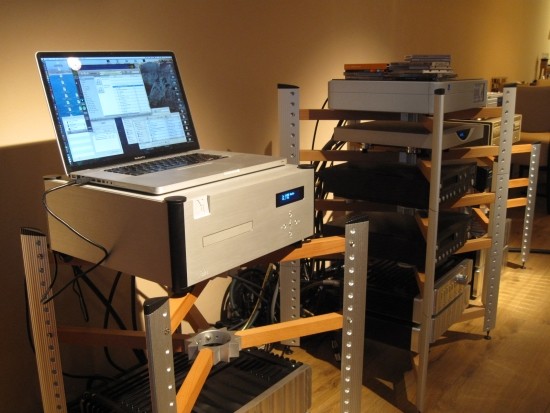
The Sound – PWD USB input versus Wadia S7i USB input
In a final attempt to make the fairest comparison possible, I also used a Macbook Pro, playing via USB into either the PWD MKII or the Wadia S7i. Now this was one interesting comparison, again with a surprising twist. Regular readers know that I don’t much like the sound of the Macbook Pro, rather preferring a full size tower computer for its fuller tonality. And indeed, connected to the Wadia with a standard USB cable, I recognized the typical Macbook Pro leanness. It is an open, articulate, highly refined sound, but it lacks bass power and depth of colour, also when connected to the Wadia S7i. But it isn’t all bad, as there is very good soundstaging, a total lack of agression and enough fluidity. Not expecting anything I moved the USB cable and interlinks to the PWD and it play. My response: HOLY MOLY! I couldn’t recognize the Macbook any more! There was a full bass, making for a very solid foundation, a midrange just as articulate as on the Wadia, but fuller, more organic and the treble was comparable, and just as smooth. What’s more: the soundstaging was now a lot better, reminiscent of what the PWD sounded like playing the WAV file via the bridge. Uncanny. Just to be certain, I switched back to the Wadia and re-played the same audio file through its USB input. Not bad at all, but lacking the full tonality and organic presentation of the PWD. This isn’t the Wadia’s fault, as all other USB dacs that I tried yielded similar results. I guess that the extra Digital Lens inside the PWD MKII really does pay off. Quickly switching inputs on the Wadia and playing the original CD brought matters back to normal, and reestablishing the Wadia as being even more organic and smooth. Interesting side note: the Wadia, playing the original CD sounded more fluid and smoother but also less focused and 3D-layered than the WAV playing via Macbook into the PWD’s USB input. The latter’s soundstaging was however slightly etched, almost too precise, too good. This is a matter of taste. I can imagine that some badly recorded CD’s or recordings sound better through the more forgiving Wadia while relaxed recordings will sound more spectacular through the PWD’s USB input. Which of the two is more natural, more accurate, or more valid? This is a question that only you, dear reader, can answer. Matter of the fact is that the Wadia is a superb CD player and the PWD is a superb DAC/Streamer.
Conclusion
The MKII upgrade literally transforms the PWD, giving it more smoothness, more fluidity, airier, more refined treble and state of the art soundstaging, pushing its performance so far that it can comfortably play in the premier league, not even being embarrased by the very best CD players I know. It is not entirely as organic as the Wadia S7i or as creamy and velvety as the Levinson 390S. But it has better soundstaging, focus, rhythm, bass solidity and sheer jump-factor than either of them. I rank it just as high as the Linn Klimax DS/0. They have very different characters but each has uniquely appealing qualities and to be honest: I’m having a hard time choosing between these two streamers. Luckily, I don’t have to:-)
Update 10 april 2012: Running in
It is said that the input board needs to run in for quite some time. Therefore I have repeated the comparisons after two weeks of use but could not yet detect any differences. I felt that the PWD sounded precisely like it did when I first installed the board. In the meantime the unit has been switched on for a month now, although I haven’t been playing music continuously. Still, thus far I haven’t heard the board change its characteristics. Comparing to various resident dacs and streamers, as well as to ones I have over for review, I’m faily certain that I hear the same differences that I noted at the time when I wrote this review.
DAC Firmware version swapping
It is also said that older firmware version 2.0.2 sounds better than the newer version 2.1.0 that my unit shipped with. So, I now ran the test and swapped back and forth between the two versions several times, playing various pieces of music, continually side-comparing with the Meridian Sooloos MC200 through the Levinson 360S DAC. First thing I can report: all the forum-people who hear differences aren’t crazy. There is in fact a considerable difference in sound character between the two versions. The difference is even so big that you could swear you’re listening to two different dacs.
While version 2.1.0 sounds bold, lively, tight and also a bit dry (but so do the Wadia’s I compared the PWD MKII with, and you can compensate for this with powercords, placement and interlinks), version 2.0.2 sounds much more fluid and organic. Chords and voices float more freely out of the speakers and treble decays seem to go on longer.
But I also feel that version 2.0.2 can be said to lack some power and expression compared to version 2.1.0. It can sound a little smoothed over, which is excellent for some music, but less welcome for more dynamic music that depends on articulate transients and power as opposed to richness and fluidity. But I guess this is something that affects not only the PWD and indeed, when comparing to the Levinson 390S cd player (as opposed to the Wadias), the sound of PWD version 2.0.2 is closer to it than version 2.1.0. Overall I quite like version 2.1.0’s solidity (bass and otherwise) but the treble can indeed be a bit dry and version 2.0.2 certainly goes a long way towards curing this.
The jury’s still out on which version I prefer overall. More listening will be needed for that, but at least it is crystal clear that these differences do excist. The good news is that you can decide for yourself which version you like better because swapping them is a piece of cake.
Update 21 april 2012: Running in more
Now that the PWD has been fed a music signal 24/7 for more than 10 days, I feel that indeed I now start to hear changes. The PWD’s basic character hasn’t changed, but treble seems smoother and more fluid and the whole impression is of a less stressed, more relaxed feel with a little more warmth.
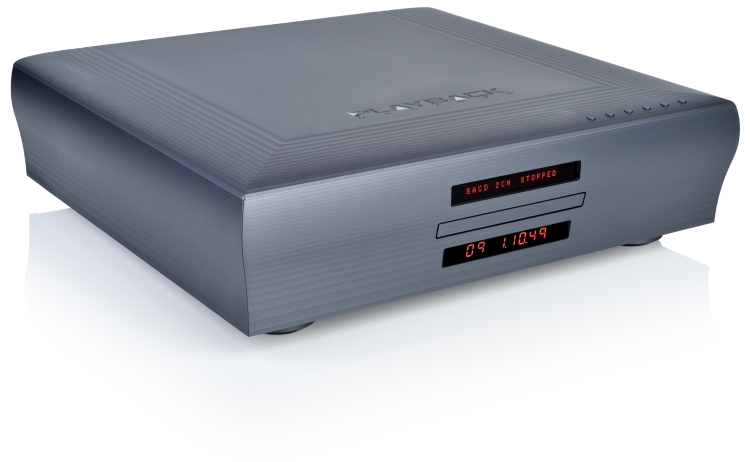







Hi Christiaan. Any plans to review the Direct Stream DAC? Would be interesting to know what PS Audio has been up to since the MkII.
Hi Thomas, that’s not a bad idea, I’ll see if I can obtain a review sample.
Good news: the DirectStream DAC will be reviewed, together with the DirectStream Memory player (DMP) as soon as the latter are available in the Netherlands, which is hopefully later this year (2016).
Just a heads up: the PS Audio Directstream DAC + Memory Player review is now published.
Awesome, thanks! I based my original purchase on your review, really enjoy the comparisons with similar gear, it gives you a reference usually missing from other reviews.
Nice review. Did you ever decide on your favorite firmware?
Hi Dennis, sorry, I can’t recall what firmware was best for me at the time but I’m sure that plenty new versions were issued that I missed after selling the unit a long time ago. The main thing to take away from this is that firmware matters for the sound quality and so I encourage people to just give it a try, especially since it’s pretty easy to do.